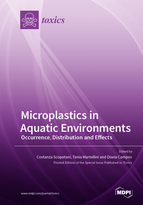Microplastics in Aquatic Environments: Occurrence, Distribution and Effects
A special issue of Toxics (ISSN 2305-6304). This special issue belongs to the section "Emerging Contaminants".
Deadline for manuscript submissions: closed (20 May 2022) | Viewed by 55679
Special Issue Editors
Interests: analytical chemistry; environmental analysis; environmental chemistry; emerging contaminants; microplastics; nanoplastics
Interests: environmental chemistry; POPs (persistent organic pollutants); emerging pollutants; risk assessment of POPs; remote area; indoor air quality (IAQ); aerosol; long-range transport; distribution and fate of contaminants; source apportionment; microplastics; house dust; gas-particle partitioning; flame retardants; pesticides; GC-MS; HPLC; elementar analysis; levoglucosan and biomass burning sources
Special Issues, Collections and Topics in MDPI journals
Interests: micro (nano) plastics; ecotoxicology; aquatic ecosystems; aquatic invertebrates; multigeneration; mesocosms; food webs; biomarke
Special Issue Information
Dear Colleagues,
The large production and widespread daily consumption of plastic materials, which began in the last century, coupled with often-inadequate collection and recycling systems, have made plastics and, consequently, microplastics ubiquitous pollutants.
The scientific community is increasingly showing its concern about microplastic pollution and the possible effects on the biota and environment. Aquatic ecosystems, such as rivers, lakes, seas and oceans, seem to act as major sinks for plastics and microplastics. Microplastic pollution is so widespread that we might assume no aquatic environment has been left untouched. Despite it having been more than a decade since the scientific community started to focus on microplastics, and despite a large number of peer-reviewed papers published on this research topic, there are still several gaps that need to be filled. The lack of method harmonization for sampling, treating and analyzing samples hampers the comparability of the studies conducted to date. Furthermore, microplastics’ effects on biota and humans are still poorly understood. Another important and little-investigated aspect is the distribution and potential effects on the environment of the so-called "bioplastics" or “biobased materials” that are replacing traditional plastics in some sectors but that also have critical issues.
This Toxics Special Issue welcomes any novel studies focusing on microplastics in aquatic environments, their occurrence and distribution, and the effects they might have on the environment and the biota. Research examining the sources of plastic pollution in aquatic ecosystems, current and future methodologies for microplastic sampling and analysis, and the ecological risks posed by microplastics are also welcome.
Dr. Costanza Scopetani
Dr. Tania Martellini
Dr. Diana Campos
Guest Editors
Manuscript Submission Information
Manuscripts should be submitted online at www.mdpi.com by registering and logging in to this website. Once you are registered, click here to go to the submission form. Manuscripts can be submitted until the deadline. All submissions that pass pre-check are peer-reviewed. Accepted papers will be published continuously in the journal (as soon as accepted) and will be listed together on the special issue website. Research articles, review articles as well as short communications are invited. For planned papers, a title and short abstract (about 100 words) can be sent to the Editorial Office for announcement on this website.
Submitted manuscripts should not have been published previously, nor be under consideration for publication elsewhere (except conference proceedings papers). All manuscripts are thoroughly refereed through a single-blind peer-review process. A guide for authors and other relevant information for submission of manuscripts is available on the Instructions for Authors page. Toxics is an international peer-reviewed open access monthly journal published by MDPI.
Please visit the Instructions for Authors page before submitting a manuscript. The Article Processing Charge (APC) for publication in this open access journal is 2600 CHF (Swiss Francs). Submitted papers should be well formatted and use good English. Authors may use MDPI's English editing service prior to publication or during author revisions.
Keywords
- microplastics
- bioplastics
- aquatic ecosystems
- microplastics effect assessment
- microplastics and risk assessment
- microplastic methodologies
- plastic pollution
- analytical methods harmonization
- quality control









